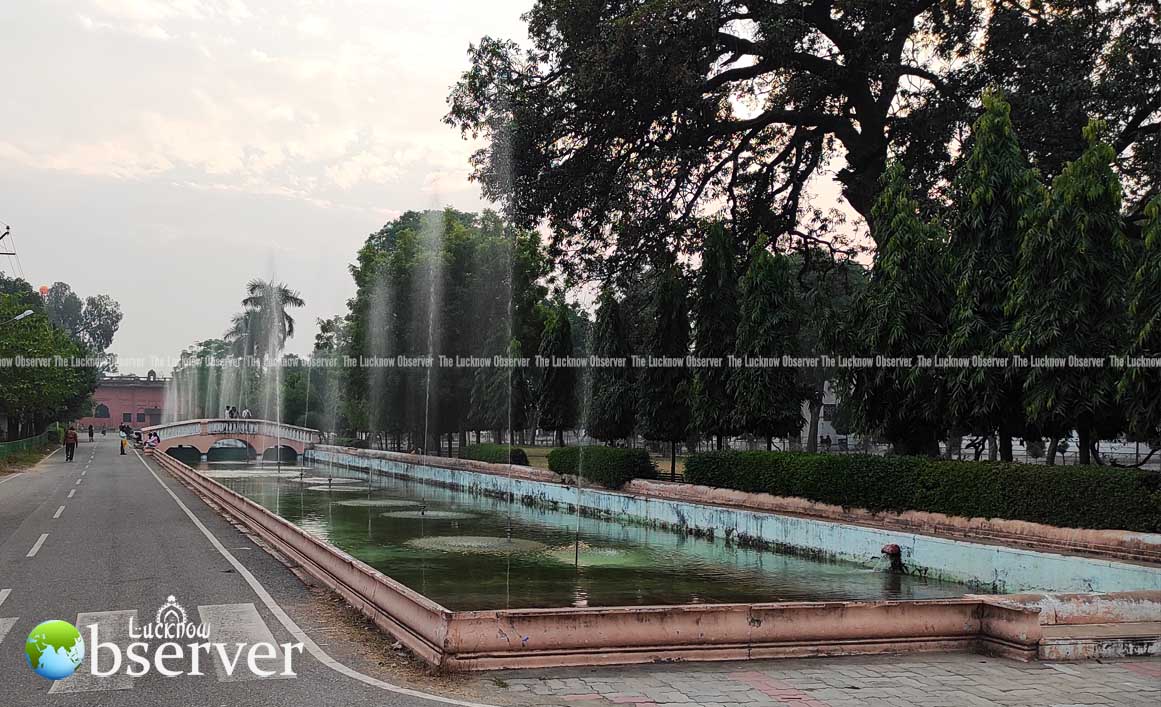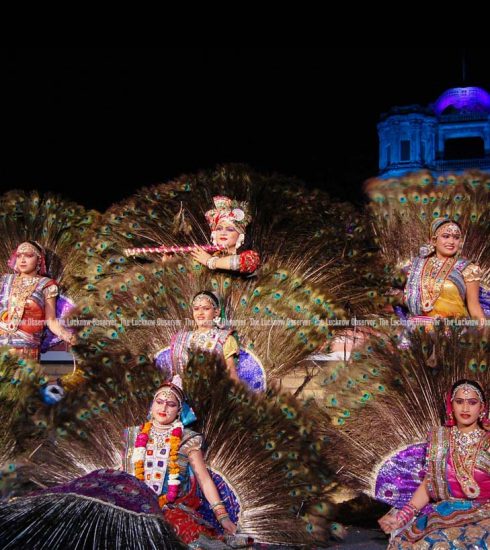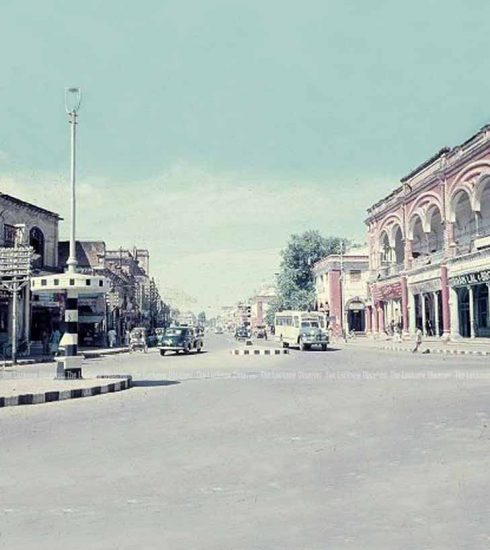Order from Chaos
The Journey of Fountains Through the Ages
Travelling around in the City of Nawabs, we can see a unique architectural element that is quite common to a lot of structures in the city. Be it the age-old Imambaras or the recent Janeshwar Mishra Park, fountains are an integral part of our architectural and historical structures.
Fountain, in landscape architecture, is a stream of water confined mainly for purposes of decoration, particularly a falsely produced jet of water or the structure from which it rises.
Fountains have been a significant element in the plan of gardens and public spaces since ancient times. An early example is well preserved in the engraved Babylonian basin (c. 3000 BC) found at Tello, the ancient Lagash in Mesopotamia. An Assyrian fountain revealed in the valley of the Comel River contains basins cut in solid rock and descending in steps to the river. Small channels led the water from one basin to the other, the lowest of which was decorated by two rampant lions in relief.
Fountains have evolved quite a lot over the ages. To understand the modern uses of fountains, we need to see the changes that took place over the time in various ages.
Greek
Throughout the Aegean civilization, as in later Hellenic Greece, springs were regularly considered holy and temples were built around them, the water often flowing out into non-natural basins. In historic Greece, further advanced fountains existed; both literary mentions and unearthed remain abound. Columns bound some, as at Lerna. The city of Corinth was noted for its fountains, predominantly the spring dedicated to the nymph Pirene. Greek fountains were serviceable as well, being provided with ample draw basins and reservoir supply and often sheltered by a portico.
Roman
In Roman civilization, water was disseminated from each terminal reservoir, or castellum, to baths and big houses as well as to many civic fountains that provided the bulk of the population. Examples exposed at Pompeii illustrated types, the more ornamental courtyard fountain of the aristocratic house and the useful public-street fountain. The latter comprised of a humble quadrangular stone basin with a small platform above it engraved with a human or animal head from whose mouth water ran. The lip of the basin was serrated for overflow.
In addition to the above types, the Romans developed the nymphaeum, a purely ornamental type of fountain that originated in Hellenistic times. In early Christian times, fountains were positioned in the entrance court of the Christian basilica as symbols of purification-e.g., Old St. Peter’s, Rome. Similar courtyard fountains continued to be used in the convents of Western Europe and the Byzantine Empire (e.g., Cluny; Vatopedi on Mount Althos).
Medieval European In the early Middle Ages in Europe, decorative and architectural treatment of fountains went out of use; wells supplied the greater part of the necessary water. From the 12th century, however, public fountains began to reappear, and the spring fountains received architectural treatment. The archetypal form of the latter consisted of a large basin reached by a downward stairway and covered over with a vault, sometimes enclosed and sometimes supported only on piers. The public fountains of the medieval towns usually had a polygonal or circular basin, sometimes lobed, in the centre of which rose a column or pier carrying a series of jets. The architectural specifics are of infinite variety. Fountains were a peculiar feature of the communal building activities of the late Middle Ages, often ordered by guilds. Few of these survive. A remarkable example is the Schöne Brunnen at Nürnberg (1398), eminent by its high, rich Gothic spirelet with many sculptures and ironwork railing.
Islamic
The fountains of Muslim countries are of great importance, particularly the public drinking fountains, called sabeel. They are an establishment in the East. A common type is the simple spout and basin enclosed within an elegant niche. The more aspiring designs take the form of a richly decorated pavilion
Renaissance and Baroque
The Renaissance in Italy began a new stage of fountain design in which sculpture became conspicuous. A common type was an arrangement of round or multilateral basins on a vertical support capped by a fountain figure from which water spouted. During the following period of the Italian Baroque, fountains became complex compositions of basins, sculpture, and water display. Rome is well known for its many fountains of baroque design, particularly the Fountain of the Rivers (1648–51) in the Piazza Navona by Giovanni Bernini and the Trevi fountain (completed 1762) by Niccolo Salvi. Italian example set the scheme for massive civic fountains and for ornate garden fountains in northern and Western Europe.
Modern
In the 19th and 20th centuries fountains did not lose their fame, although quality and imagination is less obvious. Accounts have provided occasion for ambitious fountain displays. Among the many examples are the Crystal Palace at Sydenham, London, the World’s Columbian Exposition at Chicago, Ill. (1893), and the New York World’s Fair of 1939. At the Festival of Britain, London (1951), a mobile water sculpture composed of pivoted vessels was set in motion by changing points of gravity. When each receptacle was filled, it would overturn only to right itself and be filled again with water from above. Of permanent fountains, a fine modern example, although derivative in design, is the Buckingham Memorial Fountain in Chicago (1927) by Jacques Lambert.
The design of the Islamic garden spread throughout the Islamic world, from Moorish Spain to the Mughal Empire in the Indian subcontinent. The Shalimar Gardens built by Emperor Shah Jahan in 1641, were said to be ornamented with 410 fountains, which fed into a large basin, canal and marble pools.
Another example of the use of fountains in Islamic Architecture in Modern times can be seen in the Taj Mahal. The large square of the riverfront is divided by two main paths (khiyaban) into four quadrants; narrower cross-axial paths in turn subdivide each quadrant, so that sixteen sub-quadrants are made; and a pathway, which connects with all the sub-walkways, encloses the garden as a whole. At the crossing of the pathways in the centre of the garden is a raised area (chabutra) of white marble with an ornamental pool (hauz) containing five fountains.
The Swaminarayan Akshardham Temple in New Delhi also houses a wonderful fountain system, known as the Yagnapurush Kund.The Sahaj Anand Water Show calls the Yagnapurush Kund its home. The musical fountain presents a show of about 24 minutes in which the circle of life is depicted.Areproduction of grand customary step-wells, it measures 300′ x 300′ and has 2,870 steps and 108 small shrines. The nine-lotus design of the central pool is animitation of a ritual yantra or arrangement used in sacred Hindu rites.
Coming to the city, fountains can be seen in almost all the structures that are present today. A fountain can be seen inside the Chhota Imambara complex, directly in front of the main structure. A sight to behold, it is the first thing that captures a visitor’s attentionwhen they enter the complex.
Talking of modern designs, fountains can be abundantly seen in the Ambedkar Park, and Janeshwar Mishra Park as well. The Musical fountain in Ambedkar Park presents an ethereal sight with its music and varied colours seemingly making the water come alive.
With the Gomti Riverfront project promising musical fountains and world-class fountains, we can be sure that the fountains have come a long way from the roman aqueducts to the modern light and sound shows.
Siddhant Agarwal
The writer loves to spend time penning down his thoughts and reading books.
(Published in The Lucknow Observer, Volume 3 Issue 5,August 2016)

University Of Lucknow








